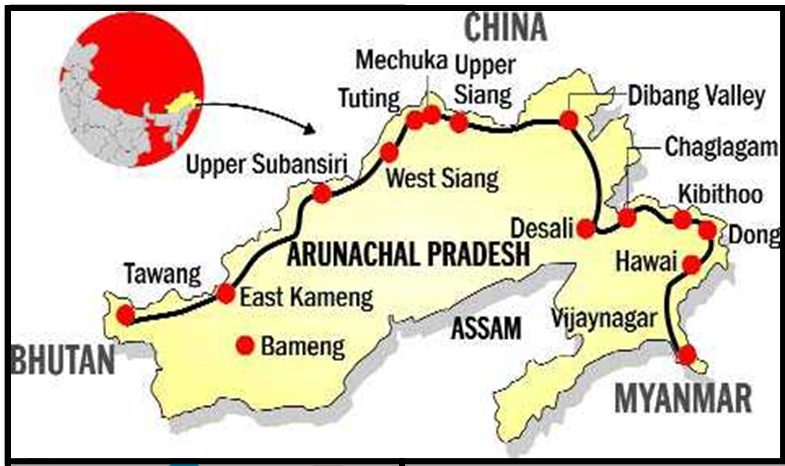UNCERTAINTY IN VIJAYNAGAR VALLEY: THE PLIGHT OF SETTLERS AND INDIGENOUS TRIBES
Syllabus:
- GS-1-
- Tribes and their welfare ,India and its Sovereignty-Geography
- Sovereign status of India
Focus :
- Tensions between the settlers, who are primarily families of Gurkhas who served in the Army and the Assam Riflees, and the Yobins, a trans-border community that was given Scheduled Tribe status, have been rising since 2020 in
Source- TH
Background
- The Miao-Vijaynagar Road, India’s longest under the Pradhan Mantri Gram Sadak Yojana, has enhanced connectivity to the remote Vijaynagar valley in Arunachal Pradesh since its opening in 2022.
- The valley, settled by ex-servicemen and their families in 1967-68, faces tensions between settlers and the indigenous Yobin community, intensified since 2020.
Land Settlement and Grievances
- The settlement plan provided non-transferable land, housing, and agricultural support to settlers but lacked promised rights such as land-holding certificates and permanent residence.
- Despite legal battles and government promises, settlers remain without proper land ownership, facing challenges in accessing government schemes and civic rights.
- Changlang is probably the only district in the Northeast where the people from India’s neighbourhood outnumber the indigenous people. As per the 2011 Census, Chakmas and Hajongs, who were displaced by the Kaptai Dam in erstwhile East Pakistan in the 1960s, constitute 29% of the district’s population of 1.48 lakh. Gurkhas constitute more than 7%. Many of them are descendants of soldiers from Nepal employed by the Indian armed forces. The district also has more than 2,600 Tibetan refugees. Yobins, concentrated in the Vijaynagar area, number about 5,000. The ex-servicemen claim there were hardly any Yobin or Lisu families around when they were own in to settle in the Vijaynagar valley.
- The settlers are worried about rising tensions and violence instigated by the All Yobin Students’ Union (AYSU) in 2020, demanding the settlers’ eviction.
- The settlers, primarily Gurkhas, were relocated to the strategically important region by the Indian government in 1967-68, aiming to populate the remote area.
| About Yobin community :
· Also called Lisu Tribe. The tribe was known for their slash and burn farming settlements and is thought to have originated in the Yunnan region of North-Western Tibet in the 18th century. · They live in the adjacent mountainous regions of Arunachal Pradesh, China, Myanmar, and Thailand and are members of the Tibeto-Burman family. · There are roughly 5,000 of them in India. · Boys and girls in Lisu or Yobin have different sets of numbered names that correspond to their birth order. A family’s eldest girl is named Ana, and their tenth daughter is named Apshi. About Vijaynagar Valley : · Myanmar borders it on the south and east, and Namdapha National Park’s dense forest borders it on the north. Tezu, Hayuliang, and Miao are nearby Indian cities. It is in Changlang District . |
Yobin Community’s Perspective
- The Yobins, recognized as Scheduled Tribes in India, assert their indigenous status, challenging settlers’ claims to land and political representation.
- Historical tensions between settlers and the Yobins, compounded by issues of citizenship and representation, lead to periodic conflicts and mistrust.
| About ST status:
· The Census of 1931 categorized certain tribes as “backward tribes” residing in “Excluded” and “Partially Excluded” areas. · The Government of India Act of 1935 marked the first instance where representation for “backward tribes” was called for in provincial assemblies. · Initially, after independence, the Constitution did not provide a specific definition for Scheduled Tribes, so the criteria outlined in the 1931 Census were followed. · Article 366(25) of the Constitution outlines the process for defining Scheduled Tribes, stating that it includes tribes, tribal communities, or groups within tribes deemed as such under Article 342. · Article 342(1) empowers the President, after consultation with the Governor of the concerned State, to specify tribes or tribal communities as Scheduled Tribes through a public notification. |
Legal Framework and Connectivity
- Legal ambiguities regarding land tenure and citizenship exacerbate tensions between settlers and indigenous communities, impacting political participation and socio-economic development.
- Improved road infrastructure and limited telecom connectivity offer glimpses of progress but fail to address deep-rooted socio-political tensions in the region.
Conclusion
- The Vijaynagar Valley represents a microcosm of India’s complex socio-political landscape, where historical settlements, legal ambiguities, and ethnic tensions intersect, posing challenges to sustainable development and social harmony.
Source:The Hindu
Mains Practice Question :
GS-2
- “Analyze the challenges faced by settlers and indigenous communities, the role of historical grievances, legal frameworks, and infrastructure development in shaping inter-community relations and governance. Assess the potential strategies for conflict resolution and sustainable development in such marginalized regions.”.”(250 words)




